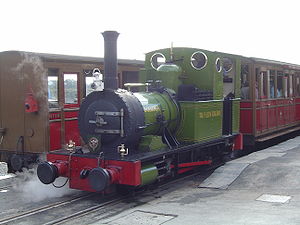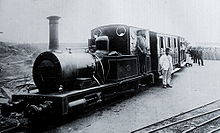- Dolgoch (locomotive)
-
Dolgoch 
Dolgoch at Tywyn Wharf in 2006 Power type steam Builder Fletcher, Jennings & Co. Serial number 63 Model Class Bb Build date 1866 Total produced 1 Configuration 0-4-0T Gauge 2 ft 3 in (686 mm) Driver diameter 2 ft 3 in (686 mm) Wheelbase 6 ft 6 in (1.98 m) Length 17 ft 5 in (5.31 m) Locomotive weight 10 tons Boiler pressure 140 lbf/in² (970 kPa) Cylinders Two, outside Cylinder size 75⁄8 in x 16 in (193 mm × 406 mm) Tractive effort 4,100 lbf (18.24 kN) Dolgoch is a narrow gauge 0-4-0 well tank steam locomotive. It was built by Fletcher, Jennings & Co. in 1866 and is one of the oldest locomotives still in active service. It was delivered to the Talyllyn Railway in 1866 [1] and continues to run on this railway.
The fictional Rheneas in The Railway Series by the Rev. W. Awdry was based on this engine.
Design
The design is unusual for a 0-4-0. The well tank engine has a long wheelbase and the driving axle is behind the firebox, which prevents the use of a conventional valve gear layout. Consequently, the Allan valve gear is driven from the leading coupled axle and doubled back to connect to the valve rods.
The engine was renamed "Pretoria" between about 1900 and 1914 in celebration of the relief of the township of Pretoria in South Africa by Lord Roberts during the Boer war. It then reverted to the original name "Dolgoch", which it retains to this day. It is likely that, in the top left photograph, the engine carries the name "Pretoria" - the freshly painted appearance hints that this photograph was taken after the repainting and name change (records indicate it was repainted and renamed around 1900[1], and would have been a bit paint-weary prior to that. Zoom in on the high resolution picture option and you can just make out very faintly ".....ria" painted on the boiler side between the chimney and the side-tank). For most of the Railway's life, engine names were painted only on one side of the engines - the North side (the side facing the station platforms which were also only on this side for the whole line). Polished brass nameplates are a feature of current preservation.
References
- ^ Boyd 1988
Bibliography
- Boyd, James I.C. (1988). The Talyllyn Railway. WildSwan Publications. ISBN 0906867460.
 Talyllyn Railway
Talyllyn RailwayMain articles 
Locomotives Locations Tywyn Wharf • Pendre • Rhydyronen • Brynglas • Dolgoch • Abergynolwyn • Nant Gwernol • Bryn Eglwys
People Wilbert Awdry • Henry Haydn Jones • William McConnel • L. T. C. Rolt • James Swinton Spooner
Miscellaneous 
This steam locomotive-related article is a stub. You can help Wikipedia by expanding it. This United Kingdom rail transport related article is a stub. You can help Wikipedia by expanding it.



